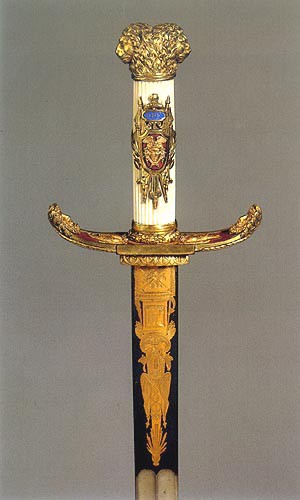The Versailles Manufactory is famed for having provided the honour arms awarded by Bonaparte to those who distinguished themselves on the field of battle. Director of the manufactory from 1798, Nicolas Noël Boutet also provided the First Consul with his sumptuous glaive (1800), with its antique-inspired decoration. The pommel, formed out of two lions' heads set back to back, is a round bulb in chased gold. The shaft or handle, in carved ivory, is ornamented on both faces with gilt silver bas reliefs of trophies, including notably a shield in red enamel and a gorgon's head in chased gold. Above the shield there is a gold and blue enamel cartouche stamped with the initials of the French republic, R.P.F. The hand guard, which at the extremities of the curve take the form of bearded male heads, is decorated with chased, bas-relief eagles and a medallion engraved with the following words: Boutet Directeur Artiste Manufre à Versailles (Boutet Director Artist Manuf[acto]ry in Versailles). The blade is made of polished steel finished with a point and decorated in its upper part with gold inlay on an depolished ground. The scabbard has the same wealth of ornamental decoration. It is made of sheets of nacre set in a gilt and chased silver frame, and it presents in the upper part medallions showing on one side the republic, and the fatherland on the other, as well as trophies of instruments representing the arts and the sciences framed by two dragons.
This is the sword to which Napoleon referred in his will as the «glaive de consul» (Consul's glaive) and which he bequeathed to his son. Left in 1815 with the Comte de Turenne, Chamberlain and Grand Maître of the emperor's garde-robe, the sword apparently never reached the Duc de Reichstadt. During the Second Empire, his cousin, the Duchesse de Camerata, daughter of Elisa, deposited it in the Musée des Souverains (Sovereign's museum) which had been created at the Louvre on the initiative of Napoleon III. It was subsequently part of the succession of the Empress Eugénie, and then given by the state to the Prince Victor Napoléon after the definitive establishment of the succession in 1924. In 1979 the First Consul's glaive entered the national collections. There exist two other swords, almost identical in form and decoration, one held at Windsor Castle and the other in the Victoria and Albert Museum. A fact which would appear to suggest that the three Consuls, Bonaparte, Le Brun and Cambacérès, each received a glaive as their badge of office.
This is the sword to which Napoleon referred in his will as the «glaive de consul» (Consul's glaive) and which he bequeathed to his son. Left in 1815 with the Comte de Turenne, Chamberlain and Grand Maître of the emperor's garde-robe, the sword apparently never reached the Duc de Reichstadt. During the Second Empire, his cousin, the Duchesse de Camerata, daughter of Elisa, deposited it in the Musée des Souverains (Sovereign's museum) which had been created at the Louvre on the initiative of Napoleon III. It was subsequently part of the succession of the Empress Eugénie, and then given by the state to the Prince Victor Napoléon after the definitive establishment of the succession in 1924. In 1979 the First Consul's glaive entered the national collections. There exist two other swords, almost identical in form and decoration, one held at Windsor Castle and the other in the Victoria and Albert Museum. A fact which would appear to suggest that the three Consuls, Bonaparte, Le Brun and Cambacérès, each received a glaive as their badge of office.
Karine Huguenaud (tr. P.H.)
July 2002


